PORSCHE BOXSTER 2005 2.G Owners Manual
Manufacturer: PORSCHE, Model Year: 2005, Model line: BOXSTER, Model: PORSCHE BOXSTER 2005 2.GPages: 276, PDF Size: 4.05 MB
Page 151 of 276
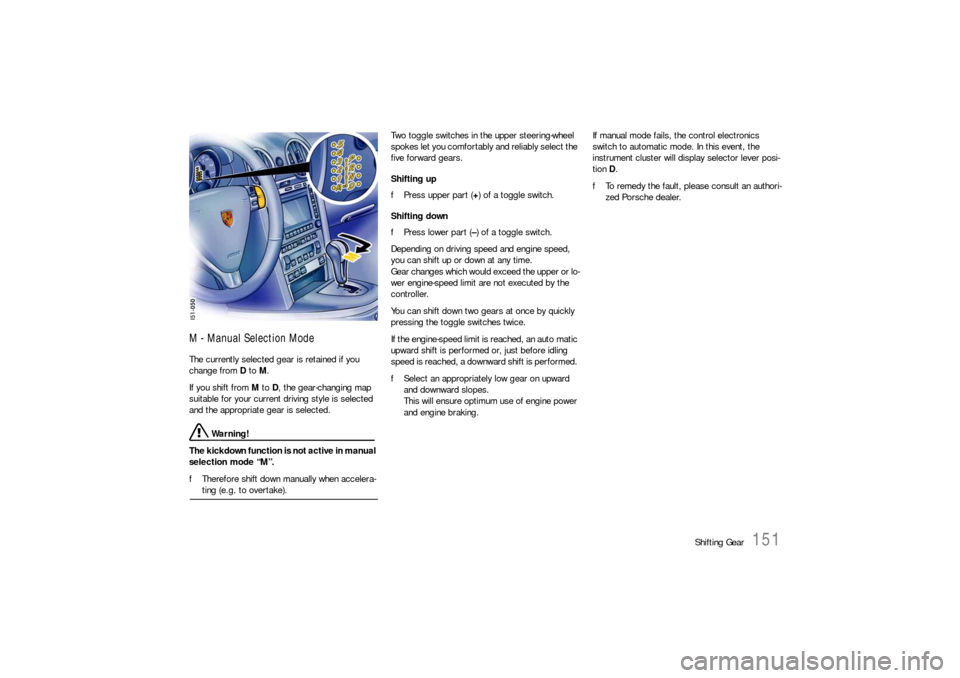
Shifting Gear
151
M - Manual Selection Mode The currently selected gear is retained if you
change from D to M.
If you shift from M to D, the gear-changing map
suitable for your current driving style is selected
and the appropriate gear is selected.
Warning!
The kickdown function is not active in manual
selection mode “M”.
fTherefore shift down manually when accelera-ting (e.g. to overtake). Two toggle switches in the upper steering-wheel
spokes let you comfortably and reliably select the
five forward gears.
Shifting up
fPress upper part (+) of a toggle switch.
Shifting down
fPress lower part (–) of a toggle switch.
Depending on driving speed and engine speed,
you can shift up or down at any time.
Gear changes which would exceed the upper or lo-
wer engine-speed limit are not executed by the
controller.
You can shift down two gears at once by quickly
pressing the toggle switches twice.
If the engine-speed limit is reached, an auto matic
upward shift is performed or, just before idling
speed is reached, a downward shift is performed.
fSelect an appropriately low gear on upward
and downward slopes.
This will ensure optimum use of engine power
and engine braking. If manual mode fails, the control electronics
switch to automatic mode. In this event, the
instrument cluster will display selector lever posi-
tion D.
fTo remedy the fault, please consult an authori-
zed Porsche dealer.
Page 152 of 276

152
Shifting Gear
Slip monitoring When the speeds of rotation of the front and rear
axles differ by more than the maximum permissib-
le value, integrated slip monitoring shifts up to the
next gear.
This increases driving stability on a slippery sur-
face.
Note
fSlip monitoring is also deactivated when
Porsche Stability Management (PSM) is swit-
ched off. Stopping fFor a brief stop, e.g. at a traffic light, leave the
selector lever in drive position and hold the ve-
hicle with the brake pedal.
fFor a longer stop with the engine running,
select position N (neutral).
fDo not hold the car on a slope using the
accelerator. Use the brake pedal or the hand-
brake instead.
fBefore leaving the vehicle, always apply the
handbrake and move the selector lever to
position P.
Parking fGo easy on the accelerator.
fWhen parking or maneuvring in a small space,
control the speed by careful use of the footbra-
ke. Driving in winter In wintery road conditions it is advisable to take
steep inclines in manual mode. This prevents the
occurrence of gear changes that could cause
wheelspin. Tow-starting, towing fPlease observe the chapter “TOWING” on Page
254.
Emergency program
Warning!
Reverse gear lock monitoring is disabled in
the emergency running program.
Damage to the vehicle may result as well as
loss of control, if the vehicle is moving for-
w a r d f a s t e n o u g h t o c a u s e r e a r w h e e l l o c k u p .
fDo not shift into R while the vehicle is moving forward.
A transmission fault is indicated by the following
symptoms:
–The 4th-gear display flashes.
– The warning “Tiptronic emergency run”
appears in the on-board computer.
– The transmission no longer shifts.
Regardless of selector lever position, 4th is
the only forward gear still available.
fAdapt your driving style to the changed hand-
ling.
fTo remedy the fault, please consult an authori-
zed Porsche dealer.
Page 153 of 276

Mobile Roofs
153 Mobile Roofs
Convertible Top......................................... 154
Windstop .................................................. 161
Hardtop .................................................... 162
Page 154 of 276

154
Mobile Roofs
Convertible Top Brief operating instructions can be found on the
back side of the driver’s sun visor.
fPlease observe the chapter “CAR CARE IN-
STRUCTIONS” on Page 191.
Warning!
When opening or closing the convertible top,
serious personal injury may occur if a per-
son’s body parts are near or in the way of the
convertible top mechanism’s moving parts.
fMake absolutely sure that nobody can be inju-
red by the convertible-top mechanism or the convertible-top compartment lid. Do not operate convertible top:
– At temperatures below 32°F/0°C.
– When one side of the car is on a curb, a hoist
or a jack.
– When items of luggage or other objects hinder
the convertible top movement or are in abrasi-
ve contact with the convertible top or rear win-
dow.
Items of luggage or objects on the luggage
tray above the engine compartment lid must
be put in the storage box or be secured under
the net to prevent their sliding out.
– Drive only with the convertible top fully open or
closed.
fAvoid frequent operation of the convertible top
with the engine off; the vehicle battery would
be unintentionally discharged rapidly.
fThe convertible top must be operated only
when the car is stationary. Make sure there is
sufficient clearance above the convertible top
(e.g. in the garage).
fTo prevent damp stains and abrasions, only
open the convertible top in a dry, clean state.
fPark your car in the shade whenever possible,
as the fabric, rubber material and color can be
harmed by long exposure to sunlight.
Door windows If the door windows are closed, they will automati-
cally be lowered a few centimeters before the con-
vertible top is opened or closed.
The door windows close automatically when the
convertible top is locked with the latching lever on
the windshield frame. Conditions for operating the convertible
top – The ignition must be switched on
(engine running or off).
– Maximum speed 30 mph (50 km/h)
The opening/closing process of the convert-
ible top will be interrupted if the maximum
speed is exceeded.
fReduce speed.
Press button again.
The opening/closing process is ended.
Page 155 of 276
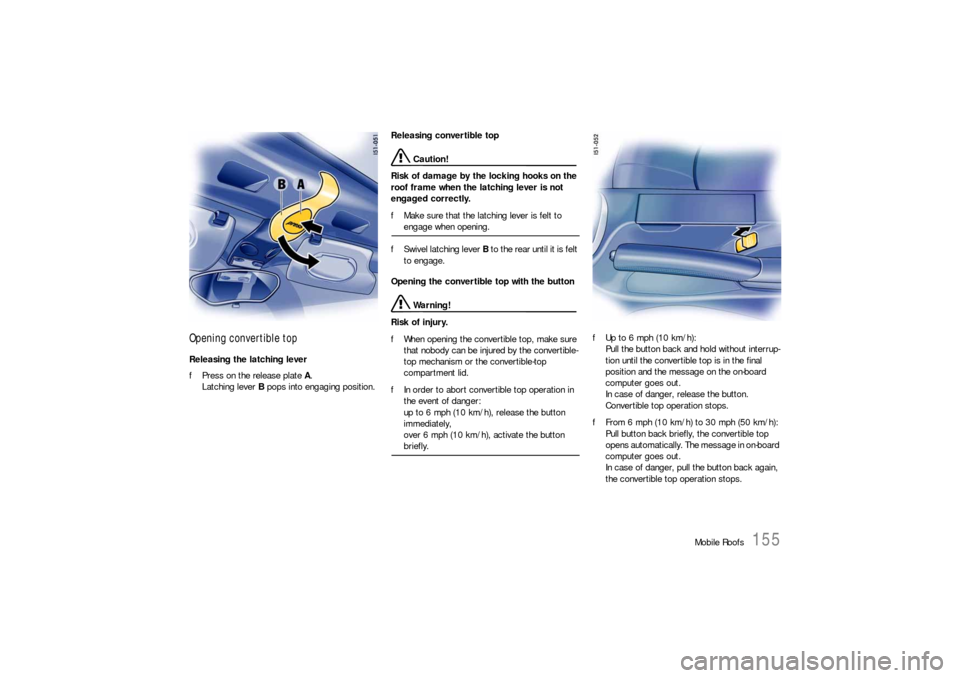
Mobile Roofs
155
Opening convertible topReleasing the latching lever
fPress on the release plate A.
Latching lever B pops into engaging position. Releasing convertible top
Caution!
Risk of damage by the locking hooks on the
roof frame when the latching lever is not
engaged correctly.
fMake sure that the latching lever is felt to engage when opening.
fSwivel latching lever B to the rear until it is felt
to engage.
Opening the convertible top with the button Warning!
Risk of injury.
fWhen opening the convertible top, make sure
that nobody can be injured by the convertible-
top mechanism or the convertible-top
compartment lid.
fIn order to abort convertible top operation in
the event of danger:
up to 6 mph (10 km/h), release the button
immediately,
over 6 mph (10 km/h), activate the button briefly.fUp to 6 mph (10 km/h):
Pull the button back and hold without interrup-
tion until the convertible top is in the final
position and the message on the on-board
computer goes out.
In case of danger, release the button.
Convertible top operation stops.
fFrom 6 mph (10 km/h) to 30 mph (50 km/h):
Pull button back briefly, the convertible top
opens automatically. The message in on-board
computer goes out.
In case of danger, pull the button back again,
the convertible top operation stops.
Page 156 of 276
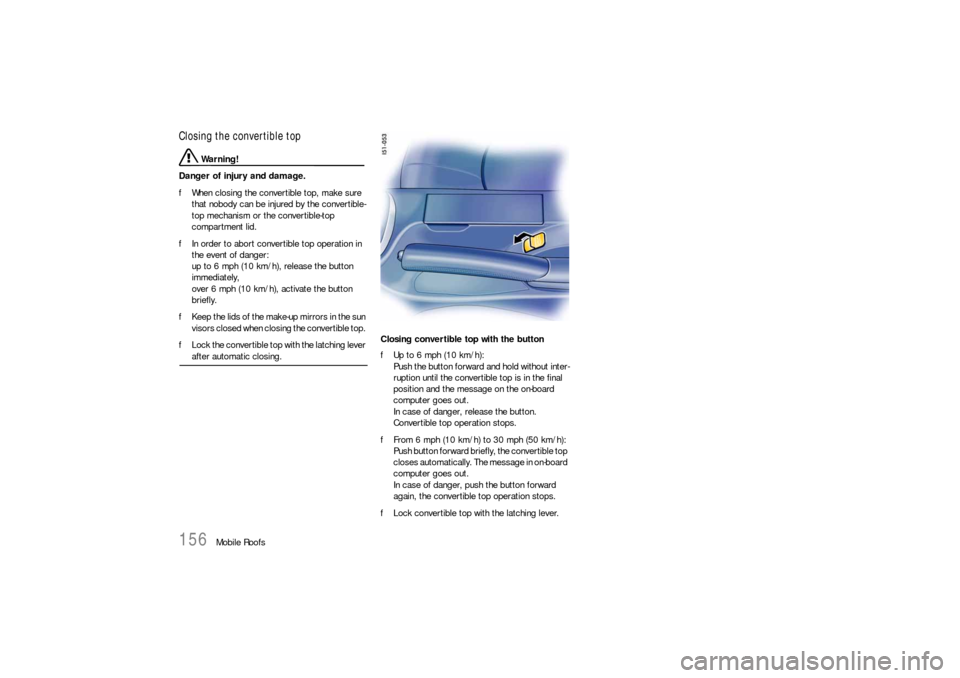
156
Mobile Roofs
Closing the convertible top
Warning!
Danger of injury and damage.
fWhen closing the convertible top, make sure
that nobody can be injured by the convertible-
top mechanism or the convertible-top
compartment lid.
fIn order to abort convertible top operation in
the event of danger:
up to 6 mph (10 km/h), release the button
immediately,
over 6 mph (10 km/h), activate the button
briefly.
fKeep the lids of the make-up mirrors in the sun
visors closed when closing the convertible top.
fLock the convertible top with the latching lever after automatic closing.Closing convertible top with the button
fUp to 6 mph (10 km/h):
Push the button forward and hold without inter-
ruption until the convertible top is in the final
position and the message on the on-board
computer goes out.
In case of danger, release the button.
Convertible top operation stops.
fFrom 6 mph (10 km/h) to 30 mph (50 km/h):
Push button forward briefly, the convertible top
closes automatically. The message in on-board
computer goes out.
In case of danger, push the button forward
again, the convertible top operation stops.
fLock convertible top with the latching lever.
Page 157 of 276

Mobile Roofs
157
Locking the convertible topfSwivel latching lever B to the front until it is felt
to engage.
The locking hook must engage in the
receptacle on the windshield frame C.
Note
If the convertible top has been opened for a longer
period, it could be necessary to assist the locking
hook engage C.
fWith the vehicle stationary, press and hold the
button for convertible top operation and pull
the convertible top to the windshield using the
handle recess D.
Emergency operation fBefore performing emergency operation, ple-
ase check:
Was the ignition switched on and the handbra-
ke applied?
Are the electrical fuses defective?
Please observe the chapter “ELECTRICAL SYS-
TEM” on Page 226.
Warning!
There is a danger of injury and risk of dama-
ge during emergency operation.
There is a danger of crushing or pinching
body parts at all moveable convertible top
parts which could cause serious personal in-
jury.
fTake great care when performing emergency
operation.
fDo not operate the convertible top during and
after emergency operation.
fLever off joint rods only with the greatest care.
fIf the convertible top is not in the rearward final
position, the convertible-top compartment lid
or the convertible top could fall down when the
joint rods are levered off.
For this reason, hold convertible top or conver-
tible-top compartment lid firmly before levering
off the second joint rod.
fDuring emergency operation, ensure that the paint is not damaged.
Page 158 of 276
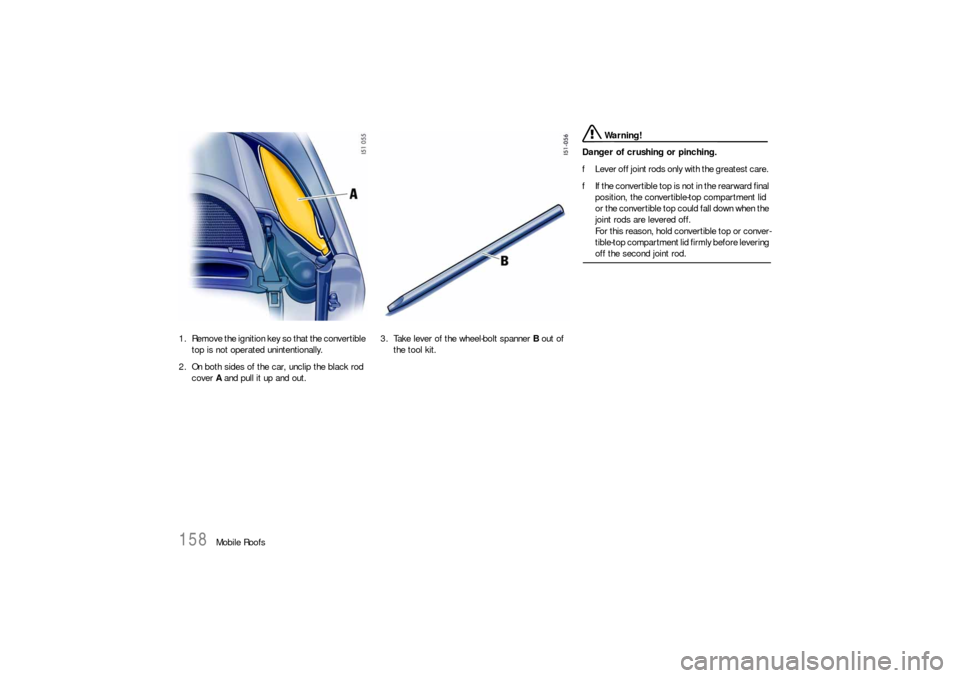
158
Mobile Roofs 1. Remove the ignition key so that the convertible
top is not operated unintentionally.
2. On both sides of the car, unclip the black rod
cover A and pull it up and out. 3. Take lever of the wheel-bolt spanner B out of
the tool kit.
Warning!
Danger of crushing or pinching.
fLever off joint rods only with the greatest care.
fIf the convertible top is not in the rearward final
position, the convertible-top compartment lid
or the convertible top could fall down when the
joint rods are levered off.
For this reason, hold convertible top or conver-
tible-top compartment lid firmly before levering off the second joint rod.
Page 159 of 276
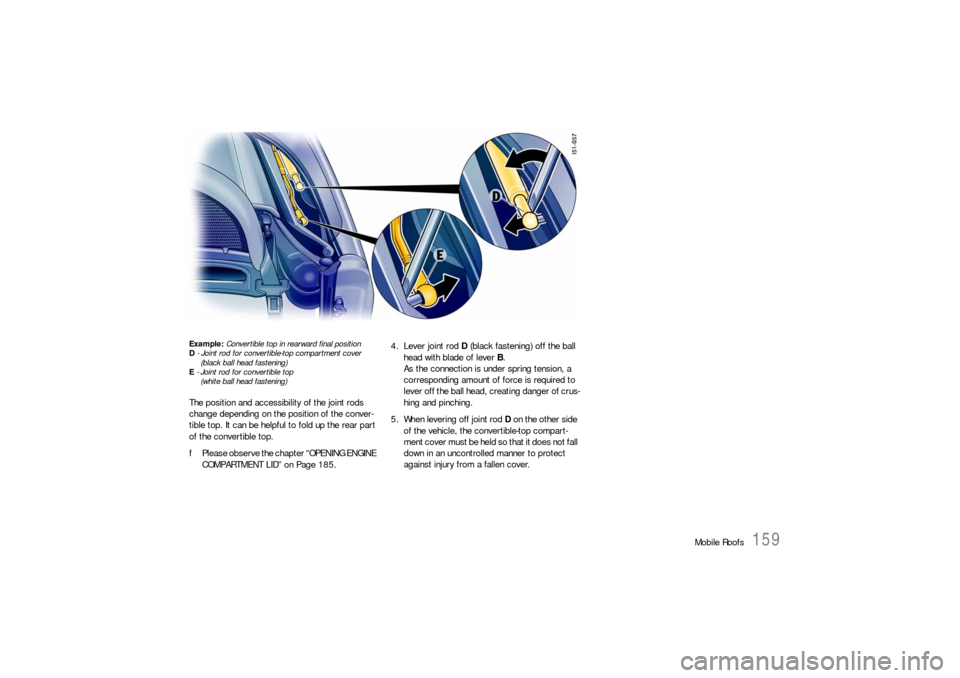
Mobile Roofs
159
Example: Convertible top in rearward final position
D - Joint rod for convertible-top compartment cover
(black ball head fastening)
E - Joint rod for convertible top
(white ball head fastening) The position and accessibility of the joint rods
change depending on the position of the conver-
tible top. It can be helpful to fold up the rear part
of the convertible top.
fPlease observe the chapter “OPENING ENGINE
COMPARTMENT LID” on Page 185.4. Lever joint rod D (black fastening) off the ball
head with blade of lever B.
As the connection is under spring tension, a
corresponding amount of force is required to
lever off the ball head, creating danger of crus-
hing and pinching.
5. When levering off joint rod D on the other side
of the vehicle, the convertible-top compart-
ment cover must be held so that it does not fall
down in an uncontrolled manner to protect
against injury from a fallen cover.
Page 160 of 276
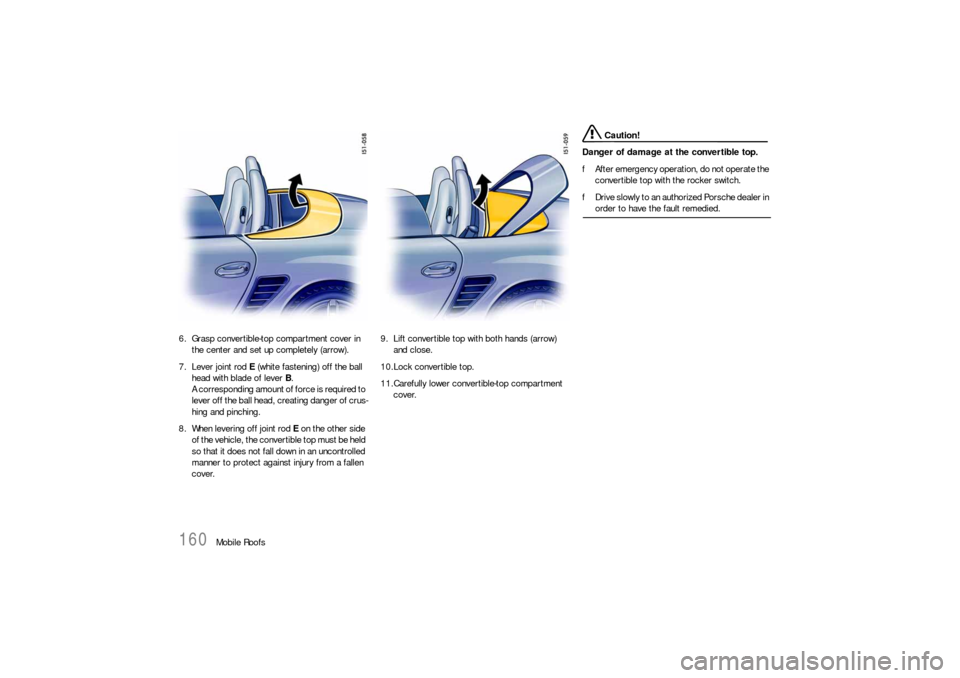
160
Mobile Roofs 6. Grasp convertible-top compartment cover in
the center and set up completely (arrow).
7. Lever joint rod E (white fastening) off the ball
head with blade of lever B.
A corresponding amount of force is required to
lever off the ball head, creating danger of crus-
hing and pinching.
8. When levering off joint rod E on the other side
of the vehicle, the convertible top must be held
so that it does not fall down in an uncontrolled
manner to protect against injury from a fallen
cover. 9. Lift convertible top with both hands (arrow)
and close.
10.Lock convertible top.
11.Carefully lower convertible-top compartment
cover.
Caution!
Danger of damage at the convertible top.
fAfter emergency operation, do not operate the
convertible top with the rocker switch.
fDrive slowly to an authorized Porsche dealer in order to have the fault remedied.